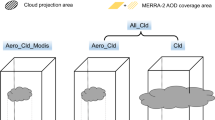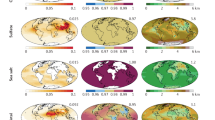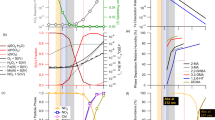Abstract
Atmospheric aerosols cause scattering and absorption of incoming solar radiation. Additional anthropogenic aerosols released into the atmosphere thus exert a direct radiative forcing on the climate system1. The degree of present-day aerosol forcing is estimated from global models that incorporate a representation of the aerosol cycles1,2,3. Although the models are compared and validated against observations, these estimates remain uncertain. Previous satellite measurements of the direct effect of aerosols contained limited information about aerosol type, and were confined to oceans only4,5. Here we use state-of-the-art satellite-based measurements of aerosols6,7,8 and surface wind speed9 to estimate the clear-sky direct radiative forcing for 2002, incorporating measurements over land and ocean. We use a Monte Carlo approach to account for uncertainties in aerosol measurements and in the algorithm used. Probability density functions obtained for the direct radiative forcing at the top of the atmosphere give a clear-sky, global, annual average of -1.9 W m-2 with standard deviation, ± 0.3 W m-2. These results suggest that present-day direct radiative forcing is stronger than present model estimates, implying future atmospheric warming greater than is presently predicted, as aerosol emissions continue to decline10.
This is a preview of subscription content, access via your institution
Access options
Subscribe to this journal
Receive 51 print issues and online access
$199.00 per year
only $3.90 per issue
Buy this article
- Purchase on Springer Link
- Instant access to full article PDF
Prices may be subject to local taxes which are calculated during checkout



Similar content being viewed by others
References
Ramaswamy, V. et al. (ed.) Climate Change 2001: The Scientific Basis. Contribution of WGI to the Third Assessment Report of the IPCC (Cambridge Univ., Cambridge, 2001)
Reddy, M. S. et al. Estimates of global multi-component aerosol optical depth and direct radiative perturbation in the LMDZT General Circulation Model. J. Geophys. Res. 110, doi:10.1029/2004JD004757 (2005)
Roberts, D. L. & Jones, A. Climate sensitivity to black carbon aerosol from fossil fuel combustion. J. Geophys. Res. 109, doi:10.1029/2004JD004676 (2004)
Bellouin, N., Boucher, O., Tanré, D. & Dubovik, O. Aerosol absorption over the clear-sky oceans deduced from POLDER-1 and AERONET observations. Geophys. Res. Lett. 30, doi:10.1029/2003GL017121 (2003)
Christopher, S. A. & Zhang, J. Shortwave aerosol radiative forcing from MODIS and CERES observations over the oceans. Geophys. Res. Lett. 29, doi:10.1029/2002GL014803 (2002)
Kaufman, Y. J. et al. Operational remote sensing of tropospheric aerosol over land from EOS moderate resolution imaging spectroradiometer. J. Geophys. Res. 102, 17051–17068 (1997)
Tanré, D., Kaufman, Y. J., Herman, M. & Mattoo, S. Remote sensing of aerosol properties over oceans using the MODIS/EOS spectral radiances. J. Geophys. Res. 102, 16971–16988 (1997)
Herman, J. R. et al. Global distribution of UV-absorbing aerosols from Nimbus 7/TOMS data. J. Geophys. Res. 102, 16911–16922 (1997)
Wentz, F. A well calibrated ocean algorithm for SSM/I. J. Geophys. Res. 102, 8703–8718 (1997)
Andreae, M. O., Jones, C. D. & Cox, P. M. Strong present-day aerosol cooling implies a hot future. Nature 435, 1187–1190 (2005)
Osborne, S. R. & Haywood, J. M. Aircraft observations of the physical and optical properties of major aerosol types. Atmos. Res. 73, 173–201 (2005)
Dubovik, O. et al. Variability of absorption and optical properties of key aerosol types observed in worldwide locations. J. Atmos. Sci. 59, 590–608 (2002)
Takemura, T., Nozawa, T., Emori, S., Nakajima, T. Y. & Nakajima, T. Simulation of climate response to aerosol direct and indirect effects with aerosol transport-radiation model. J. Geophys. Res. 110, doi:10.1029/2004JD005029 (2005)
Collins, W. D. et al. Simulation of aerosol distributions and radiative forcing for INDOEX: Regional climate impacts. J. Geophys. Res. 107, doi:10.1029/2000JD000032 (2002)
Stier, P. et al. The aerosol-climate model ECHAM5-HAM. Atmos. Chem. Phys. 5, 1125–1156 (2005)
Kirkevåg, A. & Iversen, T. Global direct radiative forcing by process-parameterized aerosol optical properties. J. Geophys. Res. 107, doi:10.1029/2001JD000886 (2002)
Platnick, S. et al. The MODIS cloud products: algorithms and examples from Terra. IEEE Trans. Geosci. Remote Sens. 41, 459–473 (2003)
Keil, A. & Haywood, J. M. Solar radiative forcing by biomass aerosol particles over marine clouds during SAFARI-2000. J. Geophys. Res. 108, doi:10.1029/2002JD002315 (2003)
Remer, L. A. et al. The MODIS aerosol algorithm, products, and validation. J. Atmos. Sci. 62, 947–973 (2005)
Smirnov, A., Holben, B. N., Eck, T. F., Dubovik, O. & Slutsker, I. Effect of wind speed on columnar aerosol optical properties at Midway Island. J. Geophys. Res. 108, doi:10.1029/2003JD003879 (2003)
Cox, C. & Munk, W. Statistics of the sea surface derived from sun glitter. J. Mar. Res. 13, 198–227 (1954)
Schaaf, C. B. et al. First operational BRDF, albedo nadir reflectance products from MODIS. Remote Sens. Environ. 83, 135–148 (2002)
Key, J. R. & Schweiger, A. J. Tools for atmospheric radiative transfer: STREAMER and FLUXNET. Comput. Geosci. 24, 443–451 (1998)
Acknowledgements
The work by N.B., O.B. and J.H. was supported by the UK Department for Environment, Food and Rural Affairs under the Climate Prediction Programme. We thank B. Crouzille for helping with the processing of MODIS data. M. Schulz and the AEROCOM participants are thanked for their efforts and for letting us use their data. Author Contributions All authors contributed equally to this work.
Author information
Authors and Affiliations
Corresponding author
Ethics declarations
Competing interests
Reprints and permissions information is available at npg.nature.com/reprintsandpermissions. The authors declare no competing financial interests.
Rights and permissions
About this article
Cite this article
Bellouin, N., Boucher, O., Haywood, J. et al. Global estimate of aerosol direct radiative forcing from satellite measurements. Nature 438, 1138–1141 (2005). https://doi.org/10.1038/nature04348
Received:
Accepted:
Issue Date:
DOI: https://doi.org/10.1038/nature04348
This article is cited by
-
Pollution levels and health risk assessment of potentially toxic metals of size-segregated particulate matter in rural residential areas of high lung cancer incidence in Fuyuan, China
Environmental Geochemistry and Health (2023)
-
Evaluation of MACC total aerosol optical depth and its correction model based on the random forest regression
Theoretical and Applied Climatology (2023)
-
Multi-angular polarimetric remote sensing to pinpoint global aerosol absorption and direct radiative forcing
Nature Communications (2022)
-
Characterization of carbonaceous aerosols during the Indian summer monsoon over a rain-shadow region
Air Quality, Atmosphere & Health (2022)
-
Climatology and model prediction of aerosol optical properties over the Indo-Gangetic Basin in north India
Environmental Monitoring and Assessment (2022)
Comments
By submitting a comment you agree to abide by our Terms and Community Guidelines. If you find something abusive or that does not comply with our terms or guidelines please flag it as inappropriate.



